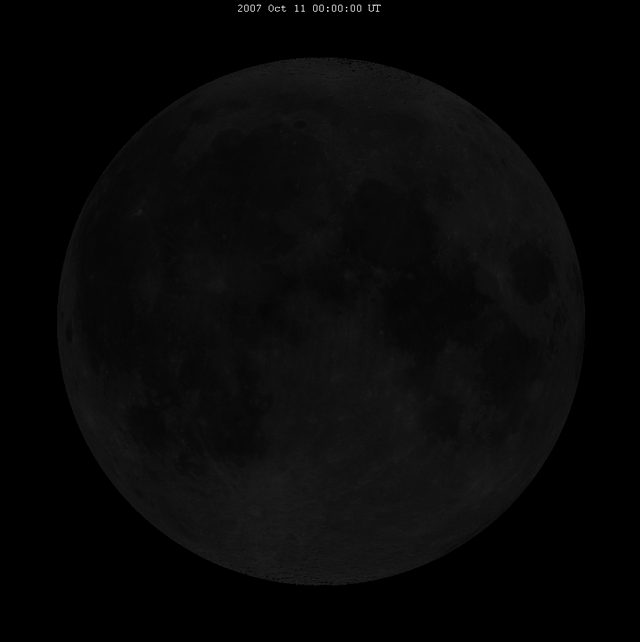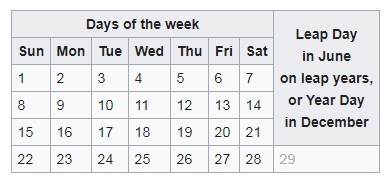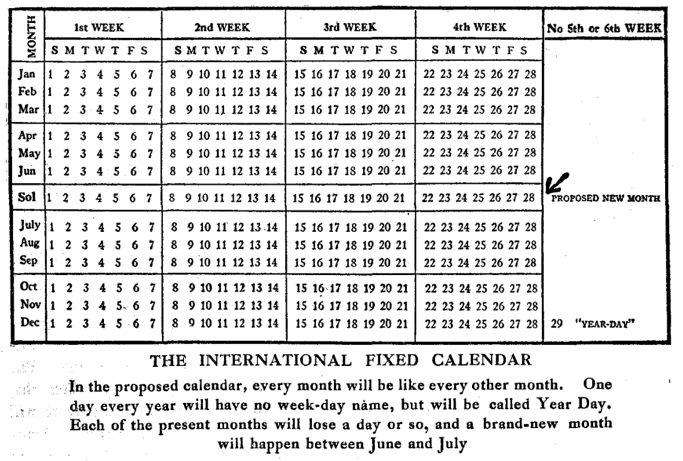

A month is based loosely on the cycle of the moon. Image via Tomruen/Wikimedia Commons.
Any calendar year has at least one Friday the 13th, and can have as many as three Friday the 13ths. This year, 2019, we have two: September 13 and December 13. However – should we ever choose to replace our standard Gregorian calendar with an International Fixed Calendar (more about it below) – we’d have 13 months in a single year, with each month featuring a Friday the 13th. That’d be 13 Friday the 13ths in one calendar year!
The month, of course, is an arbitrary concept, based loosely on the cycle of Earth’s companion moon. Months can be, and have been, many different lengths. In contrast to the Gregorian calendar, an International Fixed Calendar would be composed of 13 months, each of which would have 28 days (for a total of 364 days). With the International Fixed Calendar, weekday names would fall on the same dates each and every month. If your birthday was on a Monday one year, it’d be on a Monday every year. What this calendar system calls its Year Day would be a special day, existing outside of any week, inserted in between Saturday, December 28, and Sunday, January 1. Because Year Day would exist outside of any week or year, it’d be a holiday with no weekday name … to be celebrated as “a day out of time.”
Sound fun? Keep reading …
Of course, in a 13-month calendar system, we’d also have a new additional month. The International Fixed Calendar system calls this extra month Sol and requires that it fit between the months of June and July.
And what about leap years in the International Fixed Calendar? In a leap of year of 366 days, Leap Day would come one day after Saturday, June 28, and one day before Sunday, Sol 1. Like Year Day, Leap Day would reside outside of any week and therefore would have no weekday name.
Read more: Two Friday the 13ths in 2019

Every month in the 13-month calendar would harbor 28 days, with each month showcasing a Friday the 13th. Image via Wikipedia.
How likely are we to adopt the International Fixed Calendar? Not very likely. According to an article from CityLab.com:
Momentum behind the International Fixed Calendar, a 13-month calendar with 28 days in each month and a leftover day at the end of each year (it also followed the Gregorian rules with regards to Leap Years), was never stronger than in the late 1920s.
Similar to Auguste Comte’s positivist calendar (created in 1849), this particular 13-month invention came from the mind of Moses Cotsworth, a North Eastern Railway advisor bothered by inexplicably varying monthly earnings over the traditional 12-month period. Cotsworth’s plan quickly gained popularity among businessmen, especially in transportation and logistics. His biggest ally however, was photography pioneer and Kodak founder, George Eastman …
Read more from CityLab: The death and life of the 13-month calendar

The International Fixed Calendar of 13 months containing 28 days each. Note that all 13 months start on a Sunday and have a Friday the 13th. Illustration via CityLab.
Still, some people claim the 13-month calendar better synchronizes solar and lunar cycles, because the moon travels full circle in front of the constellations of the zodiac in about 27.3 days. (This 27.3-day period is known as the sidereal month.) Also, since the 28-day month corresponds to the mean length of the female menstrual cycle, the 13-month calendar is sometimes regarded as a feminine calendar.
On the other hand – still speaking of nature’s cycles here – the lunar (or synodic) month, which is based on the moon’s phases, lasts a solid two days longer than the 27.3-day sidereal month. The time period between successive full moons is about 29.5 days, which is about 1 1/2 days longer than the proposed 28-day calendar month.
So we’d lose our Blue Moons if we ever were to adopt the 13-month International Fixed Calendar. The second of two full moons in a single month is commonly called a Blue Moon. In this 13-month calendar, there wouldn’t be time in a single month for the moon to go from full, through all its phases, and back to full again.
But with this 13-month calendar, we’d certainly find calendar months having no full moon at all. In the 19-year Metonic cycle, we’d have 247 calendar months yet only 235 full moons, so somewhere around 12 calendar months would have no full moon in one 19-year period.
In our Gregorian calendar, only the month of February can have no full moon. This last happened in February 2018, and will next happen 19 years later, in February 2037.
Read more: Why no full moon in February 2018?
Now and again, I suppose, the International Fixed Calendar would actually find the full moon falling on Year Day or Leap Day, though I imagine quite rarely. Let me go out on the limb of modern folklore here and propose that a full moon happening outside of any week might be the International Fixed Calendar’s version of a Blue Moon!

The Gregorian dates between March and June are a day earlier during a Gregorian leap year. Image via Wikipedia.
Bottom line: The year 2019 presents a Friday the 13th in September and December. But should we ever switch over to the proposed 13-month calendar, we’d have a Friday the 13th every month.
from EarthSky https://ift.tt/30UlbHk


A month is based loosely on the cycle of the moon. Image via Tomruen/Wikimedia Commons.
Any calendar year has at least one Friday the 13th, and can have as many as three Friday the 13ths. This year, 2019, we have two: September 13 and December 13. However – should we ever choose to replace our standard Gregorian calendar with an International Fixed Calendar (more about it below) – we’d have 13 months in a single year, with each month featuring a Friday the 13th. That’d be 13 Friday the 13ths in one calendar year!
The month, of course, is an arbitrary concept, based loosely on the cycle of Earth’s companion moon. Months can be, and have been, many different lengths. In contrast to the Gregorian calendar, an International Fixed Calendar would be composed of 13 months, each of which would have 28 days (for a total of 364 days). With the International Fixed Calendar, weekday names would fall on the same dates each and every month. If your birthday was on a Monday one year, it’d be on a Monday every year. What this calendar system calls its Year Day would be a special day, existing outside of any week, inserted in between Saturday, December 28, and Sunday, January 1. Because Year Day would exist outside of any week or year, it’d be a holiday with no weekday name … to be celebrated as “a day out of time.”
Sound fun? Keep reading …
Of course, in a 13-month calendar system, we’d also have a new additional month. The International Fixed Calendar system calls this extra month Sol and requires that it fit between the months of June and July.
And what about leap years in the International Fixed Calendar? In a leap of year of 366 days, Leap Day would come one day after Saturday, June 28, and one day before Sunday, Sol 1. Like Year Day, Leap Day would reside outside of any week and therefore would have no weekday name.
Read more: Two Friday the 13ths in 2019

Every month in the 13-month calendar would harbor 28 days, with each month showcasing a Friday the 13th. Image via Wikipedia.
How likely are we to adopt the International Fixed Calendar? Not very likely. According to an article from CityLab.com:
Momentum behind the International Fixed Calendar, a 13-month calendar with 28 days in each month and a leftover day at the end of each year (it also followed the Gregorian rules with regards to Leap Years), was never stronger than in the late 1920s.
Similar to Auguste Comte’s positivist calendar (created in 1849), this particular 13-month invention came from the mind of Moses Cotsworth, a North Eastern Railway advisor bothered by inexplicably varying monthly earnings over the traditional 12-month period. Cotsworth’s plan quickly gained popularity among businessmen, especially in transportation and logistics. His biggest ally however, was photography pioneer and Kodak founder, George Eastman …
Read more from CityLab: The death and life of the 13-month calendar

The International Fixed Calendar of 13 months containing 28 days each. Note that all 13 months start on a Sunday and have a Friday the 13th. Illustration via CityLab.
Still, some people claim the 13-month calendar better synchronizes solar and lunar cycles, because the moon travels full circle in front of the constellations of the zodiac in about 27.3 days. (This 27.3-day period is known as the sidereal month.) Also, since the 28-day month corresponds to the mean length of the female menstrual cycle, the 13-month calendar is sometimes regarded as a feminine calendar.
On the other hand – still speaking of nature’s cycles here – the lunar (or synodic) month, which is based on the moon’s phases, lasts a solid two days longer than the 27.3-day sidereal month. The time period between successive full moons is about 29.5 days, which is about 1 1/2 days longer than the proposed 28-day calendar month.
So we’d lose our Blue Moons if we ever were to adopt the 13-month International Fixed Calendar. The second of two full moons in a single month is commonly called a Blue Moon. In this 13-month calendar, there wouldn’t be time in a single month for the moon to go from full, through all its phases, and back to full again.
But with this 13-month calendar, we’d certainly find calendar months having no full moon at all. In the 19-year Metonic cycle, we’d have 247 calendar months yet only 235 full moons, so somewhere around 12 calendar months would have no full moon in one 19-year period.
In our Gregorian calendar, only the month of February can have no full moon. This last happened in February 2018, and will next happen 19 years later, in February 2037.
Read more: Why no full moon in February 2018?
Now and again, I suppose, the International Fixed Calendar would actually find the full moon falling on Year Day or Leap Day, though I imagine quite rarely. Let me go out on the limb of modern folklore here and propose that a full moon happening outside of any week might be the International Fixed Calendar’s version of a Blue Moon!

The Gregorian dates between March and June are a day earlier during a Gregorian leap year. Image via Wikipedia.
Bottom line: The year 2019 presents a Friday the 13th in September and December. But should we ever switch over to the proposed 13-month calendar, we’d have a Friday the 13th every month.
from EarthSky https://ift.tt/30UlbHk

Aucun commentaire:
Enregistrer un commentaire